2020七年级英语下册 Module 11 Body language(词汇篇)试题 (新版)外研版
外研版七年级英语下册Module11Bodylanguage专题讲解

外研版七年级英语下册Module11Bodylanguage专题讲解外研版英语七年级下册Module11 Body language本单元提纲:1.主题功能:能够谈论身体语言。
2.重点单词:kiss, nod, head, shake, smile, hug等。
3.重点词组: nod one’s head, shake hands,talk to sb., close to 等。
4.重点句型:We Chinese often shake hands and smile when we meet visitors, and sometimes we nod our heads. That’s because people do different things in different countries.5.核心语法:祈使句6.智力背景补充:Olympics Slogans奥运口号2000 Sydney:Share the spirit分享奥林匹克精神2004 A thens:Welcome Home欢迎回家2008 Beijing:2012 London:Inspire a generation激励一代人重难点精讲We Chinese often shake hands and smile when we meet visitors, and sometimes we nod our heads. 当我们遇到来访者的时候,我们中国人经常握手,并且微笑,有时候还点头。
本句是由and连接的并列句,前一个分句还含有wh en引导的时间状语从句。
shake hands 意为“握手”shake hands with sb. 和某人握手shake one’s head 摇头题一:翻译题:1. 我见到他的时候,总是微笑。
2. 我爸爸妈妈站了起来,和老师握手。
In the US some people shake hands, and some kiss or hug each other.在美国,一些人握手,一些人相互亲吻或者拥抱。
七年级英语下册 Module 11 Body language世界各国的手势语文章背景素材

世界各国的手势语手势语( sign language )是体态语的一种。
体态语( body language )包括眼神、走路姿势、站立的姿势以及手势等等。
体态语十分丰富,可以表达各种思想感情,并且不同的文化有着不同的体态语。
下面是一些常见的手势语在不同文化中的含义: 1. 翘大拇指( thumb )。
在中国,翘大拇指表示“好”,用来称赞对方干得不错、了不起、高明、这个意思在世界上许多国家都是一样的。
英美人伸大拇指,向上翘,意为“ It's good. ”或“ It's OK. ”。
伸大拇指,向下翘,意为“ It's bad. ”或“ I don't agree it. ”。
但是在一些国家还有另外的意思。
比如,在日本,它还表示“男人”、“你的父亲”、“最高”;在韩国,还表示“首领”、“自己的父亲”、“部长”和“队长”;在澳大利亚、美国、墨西哥、荷兰等国,则表示“祈祷命运”;到了法国、印度,在拦路搭车时可以使用这一手势;在尼日利亚,它又表示对远方亲人的问候。
此外,一些国家还用这一手势指责对方“胡扯”。
2. 将拇指和食指( forefinger )弯曲合成圆圈,手心向前。
这个手势在美国表示“ OK ”;在日本表示钱;在拉丁美洲则表示下流低级的动作。
3. 用食指点别人。
这在欧美国家是很不礼貌的责骂人的动作。
英美人把大拇指和食指组成圆,其余三指伸直,意为“ Excellent. ” 4. 伸出食指。
在美国表示让对方稍等;在法国表示请求对方回答问题;在缅甸表示请求,拜托;在新加坡表示最重要的;在澳大利亚则表示“请再来一杯啤酒”。
5. 伸出食指和中指( middle finger )做 V 字状。
“ V ”是英文 victory 和法文 victore (胜利)的第一个字母,故在英国、法国、捷克等国此手势含有“胜利”之意。
但在塞尔维亚语中这一手势代表“英雄气概”,在荷兰语中则代表“自由”。
外研版七年级英语下 Module_11__Body_language_Unit_2__Here_are_some_ways_to_welcome_them_hhh.

shake hands and smile when they meet. They usually __________
Where are they from?
Maybe
They are from America. They are American. How do they greet? They usually _______________ shake _________ kiss _______________________ hands, when they meet. or hug each other
In Greece, it’s not at all polite! In fact, it’s very rude.
wave to say goodbye be careful in fact
挥手告别 小心 事实上
语法讲解----祈使句
But be careful!
1.—Don’t be late again, Mike? —_______________. A. No, I don’t C. Sorry, I won’t B. Don’t worry D. I don’t know
Maybe
Where are they from? They are from New Zealand. They are Maori. How do they greet?
They touch noses.
You know, when we meet others, we often use our body to greet each other. Now, let learn about our body.
head
ear
2020年春初中英语外研版七年级下册Module11Bodylanguage 课件
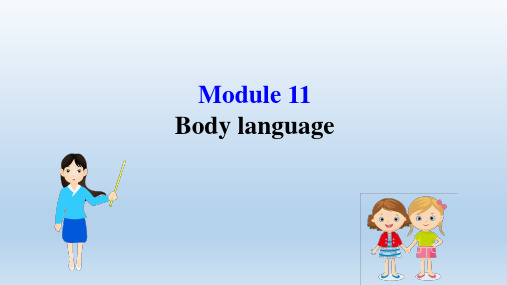
要点3 each pron. 各个; 每个 Step 1【难点·探】 (1)each作形容词, 修饰单数名词时, 动词用单数还是复 数? (2)each of them后接动词用什么形式?
Step 2【语境·悟】
* In the US some people shake hands, and some kiss or
Step 3【知识·得】 each/every/either的用法辨析
指两个或两个以上的人或事物中的“每个”。 each作形容词, 修饰单数名词, 后接单数动词。 each 作代词, 单独使用, 后接单数动词; 放在复数 名词和代词后作同位语, 接复数动词。each of them后可接(单数/复数)动词
likes
要点4 That’s because people do different things in
different countries. 那是因为不同国家的人做法不同。(P66) Step 1【难点·探】 (1)你能分析这个句子的句式结构吗? (2)because引导的是一个什么从句?
Step 2 【句型·研】 本句是一个主从复合句, because引导的是一个表语从 句。其句子结构如下图所示:
China.
要点1 Russian n. 俄罗斯人; 俄语 Step 1【难点·探】 (1)Russian作“俄罗斯人”讲时, 它的复数是什么? (2)“俄罗斯”的英语是什么?
Step 2【语境·悟】
*We’re going to have some Russian teachers at school tomorrow, and I’m welcoming the visitors. 明天我们 学校会有一些俄罗斯老师来访, 我要去迎接他们。(P66)
七年级英语下册Module11Bodylanguage知识点归纳新版外研版202005051191
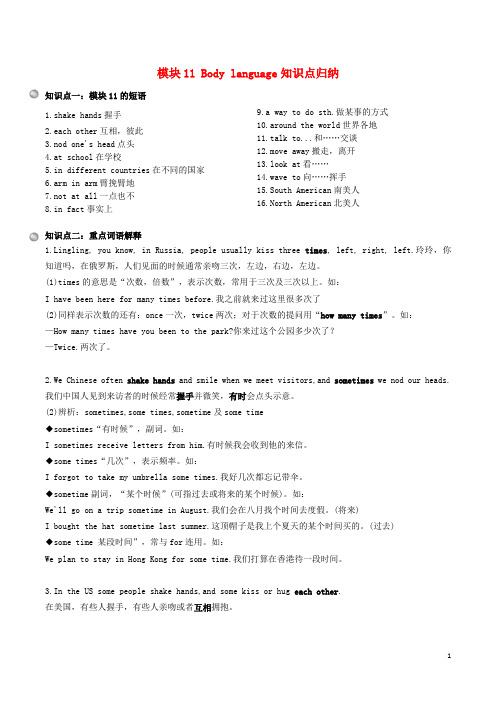
模块11 Body language知识点归纳知识点一:模块11的短语1.shake hands握手2.each other互相,彼此3.nod one's head点头4.at school在学校5.in different countries在不同的国家6.arm in arm臂挽臂地7.not at all一点也不8.in fact事实上9.a way to do sth.做某事的方式10.around the world世界各地11.talk to...和……交谈12.move away搬走,离开13.look at看……14.wave to向……挥手15.South American南美人16.North American北美人知识点二:重点词语解释1.Lingling, you know, in Russia, people usually kiss three times, left, right, left.玲玲,你知道吗,在俄罗斯,人们见面的时候通常亲吻三次,左边,右边,左边。
(1)times的意思是“次数,倍数”,表示次数,常用于三次及三次以上。
如:I have been here for many times before.我之前就来过这里很多次了(2)同样表示次数的还有:once一次,twice两次;对于次数的提问用“how many times”。
如:—How many times have you been to the park?你来过这个公园多少次了?—Twice.两次了。
2.We Chinese often shake hands and smile when we meet visitors,and sometimes we nod our heads.我们中国人见到来访者的时候经常握手并微笑,有时会点头示意。
(2)辨析:sometimes,some times,sometime及some time◆sometimes“有时候”,副词。
Module11BodyLanguage知识点总结七年级英语下册

外研七下M11知识点(单词+短语+语法)M11 Body LanguagePart One Key Words1.Russian (adj.) 俄罗斯的;俄语的;俄罗斯人的(n.) 俄罗斯人,俄语Russia (n.) 俄罗斯【类似单词】Nation——People【拓展】“国人”变复数规律:①大多数是直接在词尾加s eg: IndiaIndianIndians①单复数同形eg:ChineseJapanese①将man改成men eg:FrenchmanFrenchmen2.shake (v.) 摇晃【词形变化】shakeshookshaken【用法】shake hands with sb 和某人握手【原句】We Chinese often shake hands and smile when we meet visitors, and sometimes we nod our heads.(课本P66)3.smile (v.&n.) 微笑【短语】(v.) smile at sb. 对某人微笑(n.) with a smile面带微笑【拓展】辨析smile、laugh【原句】We Chinese often shake hands and smile when we meet visitors, and sometimes we nod our heads.(课本P66)4.time (n.) [C] 次数[U] 时间5.hug (v&n.) 拥抱6.Together (adv.) 一起,共同【短语】① put....together 把...放在一起① get together 聚会7.Each other 互相,彼此【拓展】①所有格形式:each other’s①each (pron.) 每个,各个指两者或两者以上中的每个,在句中作主语、宾语、同位语等①each of .... ....中的每一个,该结构作主语时,谓语动词用单数。
2020年外研版七年级英语下册Module 11 Body language模块检测题及答案
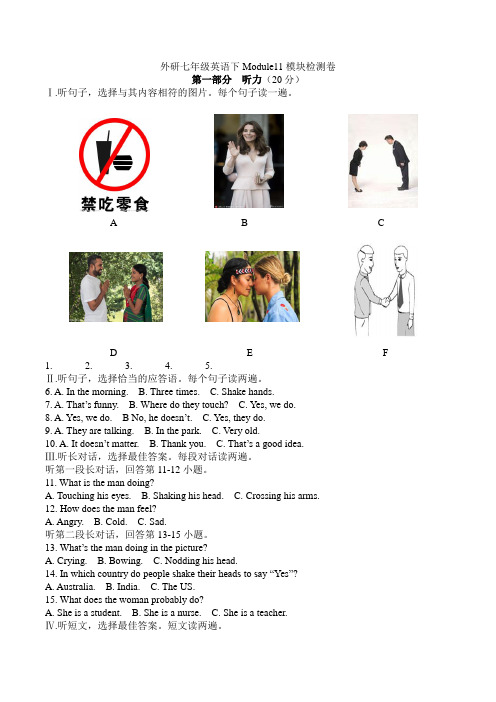
外研七年级英语下Module11模块检测卷第一部分听力(20分)Ⅰ.听句子,选择与其内容相符的图片。
每个句子读一遍。
A B CD E F1.______2.______3.______4.______5.______Ⅱ.听句子,选择恰当的应答语。
每个句子读两遍。
6. A. In the morning. B. Three times. C. Shake hands.7. A. That’s funny. B. Where do they touch? C. Yes, we do.8. A. Yes, we do. B No, he doesn’t. C. Yes, they do.9. A. They are talking. B. In the park. C. Very old.10. A. It doesn’t matter. B. Thank you. C. That’s a good idea.Ⅲ.听长对话,选择最佳答案。
每段对话读两遍。
听第一段长对话,回答第11-12小题。
11. What is the man doing?A. Touching his eyes.B. Shaking his head.C. Crossing his arms.12. How does the man feel?A. Angry.B. Cold.C. Sad.听第二段长对话,回答第13-15小题。
13. What’s the man doing in the picture?A. Crying.B. Bowing.C. Nodding his head.14. In which country do p eople shake their heads to say “Yes”?A. Australia.B. India.C. The US.15. What does the woman probably do?A. She is a student.B. She is a nurse.C. She is a teacher.Ⅳ.听短文,选择最佳答案。
外研版英语七年级(下) Module 11 .Body language

外研版英语七年级(下)Module 11 .Body language一.重点短语句型归纳。
1. body language 身体语言2. touch noses 碰鼻子touch v.接触、触摸、打动n.接触、联系、关系be/keep in touch with 和…保持联系get in touch with 和……取得联系3. nod head 点头4. in different countries在不同的国家5. shake hands 握手shake hands with…和…握手6. three times 三次7. each other 互相所有格形式:each other’seach of 后面接复数名词或代词复数,但做主语的时候,谓语要用单数。
Each of us has to take one. each 做主语。
我们每个人必须拿一个We each have to take one. we是主格,做主语。
8. best friend 最好的朋友9. film star 电影明星10. foreign students 外国学生11. talk to…与….交谈talk with…和….交谈talk about…谈论关于…12. stand close to 站得近be close to…离…近13. personal space 私人空间14. arm in arm 臂挽臂hand in hand 手拉手face to face 面对面shoulder to shoulder 肩并肩15. south Americans 南美人16. move away 离开,搬走move on 继续移动17. not at all 一点也不18. be polite to do …做…是礼貌的19. look at 看20. in other countries 在其他国家21. say goodbye 道别say goodbye to 向…道别,向…分手say hello to 和…打招呼say sorry to 向…道歉22. wave to say goodbye 挥手说再见23. be careful = Take care!=look out 小心24. in fact 事实上25. hold on to…抓紧Hold on, please. 等一会儿26. be late for class 上课迟到27. class rules 班规28. in class 在课上29. stand in line 站成一排,排队30. on time 准时in time 及时31. enter the lab alone 独自进入实验室32. many other things 许多其他事情33. greet sb. 问候某人34. bring, take与carrybring 表示“拿来,带来”,指从别处把某人或某物带到说话人所在之处take 表示“带走,拿走”,指从说话人所在地把某人或某物带走或拿走carry仅表示“携带,带着”,不含方向二、句型。
外研版七下module 11 body language知识点总结

Module 11 Body Language1. body language 身体语言2. touch noses 碰鼻子(touch 作动词, 意为: 接触, 触摸.作名词时, 意为: 接触, 联系, 关系) be/get in touch with和……取得联系keep in touch with 和…保持联系3. nod head 点头(nod 是动词,过去式是nodded; 现在分词是nodding) nod one’s head点头nod sb. a welcome 向某人点头表示欢迎4. 一次 once; 两次 twice; 三次 three times (大于等于三的用数字+times)5. shake hand s握手 (shake 是动词,意为: 摇晃,摇动,震动) Shake hand s with sb. 和某人握手5. people do different things in different countries在不同的国家人们做不同的事情different后要用名词复数6. hug each other互相拥抱each other 为相互代词,放动词后使用,如: help each othershake hands with each other; 所有格形式: each other’s. each of 后面接复数名词或代词复数,但做主语的时候, 谓语要用单数. 如: Each of boys has to take one. 每一个男孩必须拿一个。
Hug可以作名词也可以作动词She hugged the baby in her baby in her arms and ran out. 她紧抱着婴儿跑了出去She gave me a hug. 她给了我一个拥抱Give sb a hug 给某人一个拥抱。
Each 与every 都有每个的意思,但用法不同Each 既可以作形容词,也可以做代词。
外研版七年级英语下册Module11Bodylanguage语言点素材
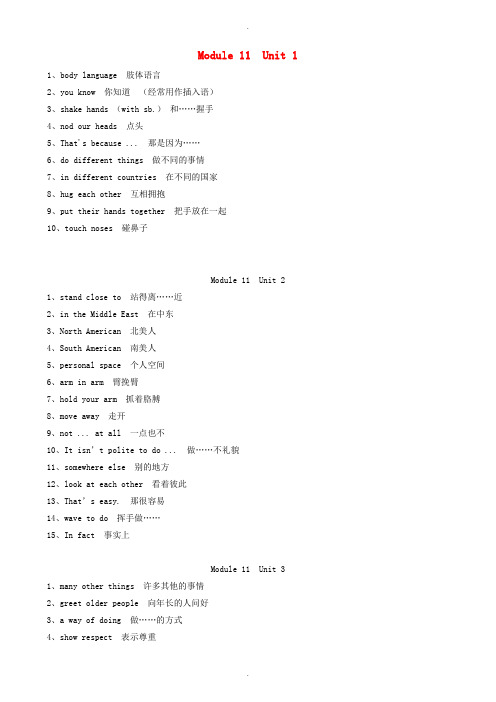
.Module 11 Unit 11、body language 肢体语言2、you know 你知道(经常用作插入语)3、shake hands (with sb.)和……握手4、nod our heads 点头5、That's because ... 那是因为……6、do different things 做不同的事情7、in different countries 在不同的国家8、hug each other 互相拥抱9、put their hands together 把手放在一起10、touch noses 碰鼻子Module 11 Unit 21、stand close to 站得离……近2、in the Middle East 在中东3、North American 北美人4、South American 南美人5、personal space 个人空间6、arm in arm 臂挽臂7、hold your arm 抓着胳膊8、move away 走开9、not ... at all 一点也不10、It isn’t polite to do ... 做……不礼貌11、somewhere else 别的地方12、look at each other 看着彼此13、That’s easy. 那很容易14、wave to do 挥手做……15、In fact 事实上Module 11 Unit 31、many other things 许多其他的事情2、greet older people 向年长的人问好3、a way of doing 做……的方式4、show respect 表示尊重.。
最新外研版七年级下册英语Module 11 Body language-模块知识点归纳
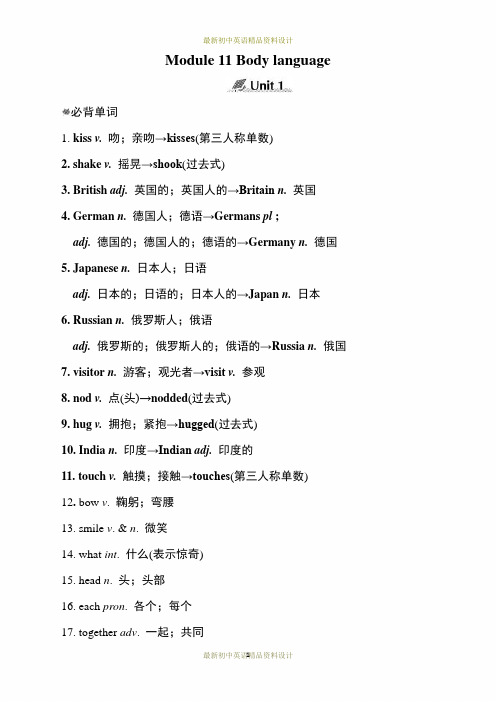
Module 11 Body language必背单词1. kiss v.吻;亲吻→kisses(第三人称单数)2. shake v.摇晃→shook(过去式)3. British adj.英国的;英国人的→Britain n.英国4. German n.德国人;德语→Germans pl ;adj.德国的;德国人的;德语的→Germany n. 德国5. Japanese n. 日本人;日语adj.日本的;日语的;日本人的→Japan n.日本6. Russian n.俄罗斯人;俄语adj.俄罗斯的;俄罗斯人的;俄语的→Russia n.俄国7. visitor n.游客;观光者→visit v.参观8. nod v.点(头)→nodded(过去式)9. hug v.拥抱;紧抱→hugged(过去式)10. India n.印度→Indian adj. 印度的11. touch v. 触摸;接触→touches(第三人称单数)12. bow v. 鞠躬;弯腰13. smile v. & n. 微笑14. what int. 什么(表示惊奇)15. head n. 头;头部16. each pron. 各个;每个17. together adv. 一起;共同18. Maori adj. 毛利人的19. nose n. 鼻子必背短语20. each other 互相21. body language 肢体语言22. in Russia 在俄罗斯23. touch noses 碰鼻子24. in the US 在美国必背句子25. We Chinese often shake hands and smile when we meet visitors, andsometimes we nod our heads.我们中国人在见到客人时常常握手并微笑,有时我们会点头。
26. That's because people do different things in different countries.那是因为不同国家的人们做法不同。
最新外研版七年级英语下册 Module 11 Body language见面基本礼仪文章背景素材

最新初中英语精品资料设计最新初中英语精品资料设计 1 见面基本礼仪1、握手 通常年长(尊)者先伸手后,另一方及时呼应。
来访时、主人先伸手以表示欢迎。
告辞时,待客人先伸手后,主人再相握。
握手的力度以不握疼对方的手为限度。
初次见面时,时间一般控制在3秒钟内。
2、介绍 介绍时应把身份、地位较为低的一方介绍给相对而言身份、地位较为尊贵的一方。
介绍时陈述的时间宜短不宜长,内容宜简不宜繁。
同时避免给任何一方厚此薄彼的感觉。
3、致意 表示问候之意。
通常在各种场合用举手、点头、欠身、脱帽等方式向相识的人打招呼。
现在详细介绍下:握手礼、名片礼、脱帽礼、拥抱礼、亲吻礼等。
名片礼:初次相识,往往要互呈名片。
呈名片可在交流前或交流结束、临别之际,可视具体情况而定。
递接名片时最好用双手,名片的正面应朝着对方;接过对方的名片后应致谢。
一般不要伸手向别人讨名片,必须讨名片时应以请求的口气,如“您方便的话,请给我一张名片,以便日后联系。
” 脱帽礼:见面时男士应摘下帽子或举一举帽子,并向对方致意或问好;若与同一人在同一场合前后多次相遇,则不必反复脱帽。
进入主人房间时,客人必须脱帽。
在庄重、正规的场合应自觉脱帽。
拥抱礼和亲吻礼:流行于欧美国家。
拥抱礼多用于官方、民间的迎送宾客或祝贺致谢等社交场合。
两人相对而立,上身稍稍前倾,各自右臂偏上,左臂偏下,右手环拥对方左肩部位,左手环拥对方右腰部位,彼此头部及上身向右相互拥抱,最后再向左拥抱一次。
亲吻礼:行亲吻礼时,往往伴有一定程度的拥抱,不同关系、不同身份的人,相互亲吻的部位不尽相同。
在公共场合和社交场合,关系亲近的女子之间可以吻脸,男子之间是拥肩相抱,男女之间一般是贴面颊;晚辈对尊长是吻额头;男子对尊贵的女宾可以吻手指或手背。
在许多国家的迎宾场合,宾主往往以握手、拥抱、左右吻脸、贴面颊的连续动作,表示最真诚的热情和敬意。
外研版七年级英语下册Module11单词短语(30张)

外研版七年级下册-M11
India ['ɪndɪə] n.印度
He comes from the Asian country of India. 他来自亚洲国家印度。
Together [tə'geðə] adv.一起;共同
They talked English together for practice. 他们一起练习讲英语。 Work together then you can make progress. 共同工作才能取得巨大进步。
外研版七年级下册-M11
Knee [niː]n.膝盖
My book dropped off my knee. 书从我的膝盖上掉落了。 She had an operation on her knee at the hospital. 她在医院做了个膝盖手术。
leg [leg]n.腿
We noticed something wrong with his leg. 我们注意到他的腿似有不便。
Russian ['rʌʃ(ə)n] n.俄罗斯人;俄语 adj.俄罗斯的;俄罗斯人的;俄语的
Can you understand Russian? 你能听懂俄语吗?
外研版七年级下册-M11
visitor ['vɪzɪtə]n.游客;观光者
Many visitor s come here every year. 每年有很多旅客来这里旅游。
外研版七年级下册-M11
Each iːtʃ]pron.各个;每个
Each student has to answer the question. 每个学生都要回答这个问题。 Everyone has to work hard. 每个人都要努力工作。
初中英语Module11Bodylanguage单元教学设计以及思维导图(20200714005153)
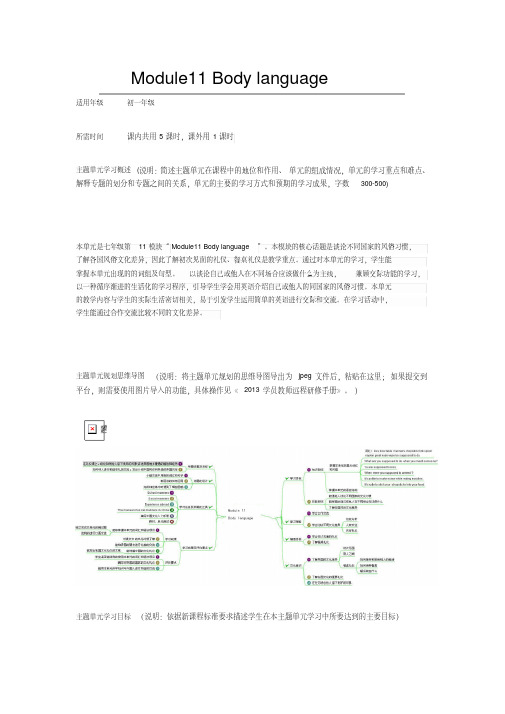
Module11 Body language适用年级初一年级所需时间课内共用5课时,课外用1课时主题单元学习概述(说明:简述主题单元在课程中的地位和作用、单元的组成情况,单元的学习重点和难点、解释专题的划分和专题之间的关系,单元的主要的学习方式和预期的学习成果,字数300-500)本单元是七年级第11模块“Module11 Body language”。
本模块的核心话题是谈论不同国家的风俗习惯,了解各国风俗文化差异,因此了解初次见面的礼仪、餐桌礼仪是教学重点。
通过对本单元的学习,学生能掌握本单元出现的的词组及句型。
以谈论自己或他人在不同场合应该做什么为主线,兼顾交际功能的学习,以一种循序渐进的生活化的学习程序,引导学生学会用英语介绍自己或他人的同国家的风俗习惯。
本单元的教学内容与学生的实际生活密切相关,易于引发学生运用简单的英语进行交际和交流。
在学习活动中,学生能通过合作交流比较不同的文化差异。
主题单元规划思维导图(说明:将主题单元规划的思维导图导出为jpeg文件后,粘贴在这里;如果提交到平台,则需要使用图片导入的功能,具体操作见《2013学员教师远程研修手册》。
)主题单元学习目标(说明:依据新课程标准要求描述学生在本主题单元学习中所要达到的主要目标)知识与技能:1、语言知识1)词汇:kiss bow table manners chopsticks fork spoon napkin greet rude wipe point stick2)短语: be supposed to do3)句型:What are you supposed to do when you meet someone? You are supposed to kissWhen were you supposed to arrived ? I was supposed to arrived at 7 ,but I arrived at 8.It’s polite to make noise while eating noodles.2、语言技能1)能描述自己或他人在不同的场合应该做什么2)讨论不同国家的风俗习惯,如初次见面的礼仪、餐桌礼仪3能掌握本单元出现的表示风俗礼仪的词组及句型,并能结合实际生活进行灵活运用这些词组及句型描述异国风俗,,提高写作水平。
外研版七年级下册英语Module11 Body language 知识点总结
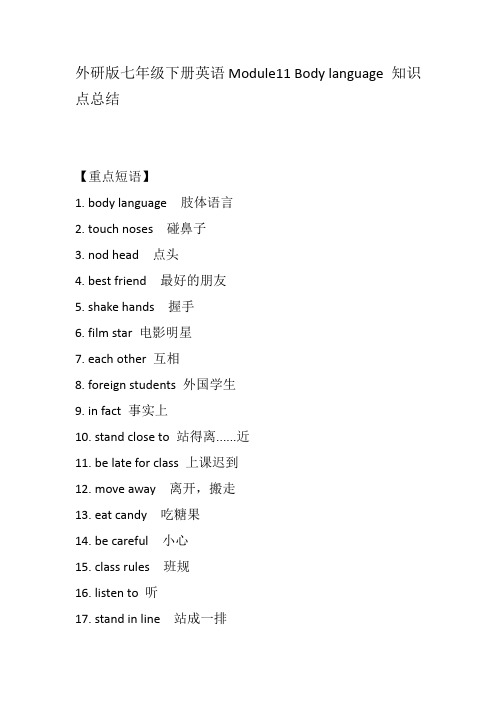
8. foreign students外国学生
9. in fact事实上
10. stand close to站得离......近
11. be late for class上课迟到
12. move away离开,搬走
13. eat candy吃糖果
14. be careful小心
15. class rules班规
14. And how do you say goodbye? That’s easy. Wave to say goodbye.如何表示告别呢?那很简单,挥手告别。
15. In Greece, it’s not at all polite! In fact, it’s very rude!在希腊,那绝对是不礼貌的!事实上,那是很粗鲁的!
7. How close do you stand when you talk to a friend?当你和朋友交谈时站得有多近呢?
8. But don’t stand too close to…
但是不要站的离……太近!
9. Give them more personal space.
给他们更多的个人空间。
16. listen to听
17. stand in line站成一排
18. enter the lab alone独自进入实验室
七年级英语下册 Module 11 Body language语言点素材 (新版)外研版
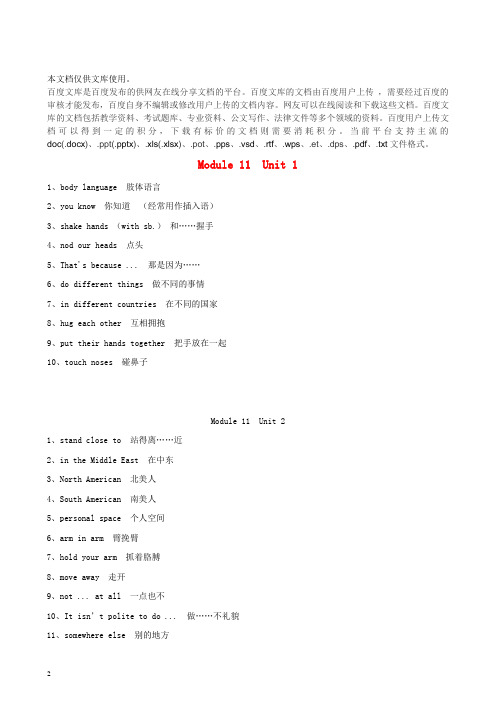
本文档仅供文库使用。
百度文库是百度发布的供网友在线分享文档的平台。
百度文库的文档由百度用户上传,需要经过百度的审核才能发布,百度自身不编辑或修改用户上传的文档内容。
网友可以在线阅读和下载这些文档。
百度文库的文档包括教学资料、考试题库、专业资料、公文写作、法律文件等多个领域的资料。
百度用户上传文档可以得到一定的积分,下载有标价的文档则需要消耗积分。
当前平台支持主流的doc(.docx)、.ppt(.pptx)、.xls(.xlsx)、.pot、.pps、.vsd、.rtf、.wps、.et、.dps、.pdf、.txt文件格式。
Module 11 Unit 11、body language 肢体语言2、you know 你知道(经常用作插入语)3、shake hands (with sb.)和……握手4、nod our heads 点头5、That's because ... 那是因为……6、do different things 做不同的事情7、in different countries 在不同的国家8、hug each other 互相拥抱9、put their hands together 把手放在一起10、touch noses 碰鼻子Module 11 Unit 21、stand close to 站得离……近2、in the Middle East 在中东3、North American 北美人4、South American 南美人5、personal space 个人空间6、arm in arm 臂挽臂7、hold your arm 抓着胳膊8、move away 走开9、not ... at all 一点也不10、It isn’t polite to do ... 做……不礼貌11、somewhere else 别的地方12、look at each other 看着彼此13、That’s easy. 那很容易14、wave to do 挥手做……15、In fact 事实上Module 11 Unit 31、many other things 许多其他的事情2、greet older people 向年长的人问好3、a way of doing 做……的方式4、show respect 表示尊重5、。
- 1、下载文档前请自行甄别文档内容的完整性,平台不提供额外的编辑、内容补充、找答案等附加服务。
- 2、"仅部分预览"的文档,不可在线预览部分如存在完整性等问题,可反馈申请退款(可完整预览的文档不适用该条件!)。
- 3、如文档侵犯您的权益,请联系客服反馈,我们会尽快为您处理(人工客服工作时间:9:00-18:30)。
Module 11 词汇篇____________________________________________________________________________________________________________________________________________________________掌握重点词汇及短语并能灵活运用。
1. smile v. &n. 微笑◆We Chinese often shake hands and smile when we meet visitors, and sometimes we nod our heads.当会见来访者的时候,我们中国人经常握手微笑,有时候我们点头。
◆What are you smiling at? 你在笑什么?◆She welcomed him with a smile. 她笑着欢迎他。
【探究总结】 smile 的用法(1)smile作动词用,常构成短语:smile at, 意为“对……微笑”;(2)smile作名词用,常构成短语:with a smile, 意为“面带微笑”;(3)smile和laugh的区别:smile一般是无声的微笑;laugh一般是有声的笑、大笑,laugh at 是1嘲笑。
2. each pron. 各个,每个◆ In the US some people shake hands, and some kiss or hug each other.在美国,有些人握手,有些人亲吻或彼此拥抱。
◆ He gave a book to each of his parents.他给他父母各送了一本书。
◆ He gave ea ch boy an apple.他给每个男孩一个苹果。
【探究总结】each 形容词代词①each 和other构成相互代词each other, 相当于one another,而every不和other连用②each可指两个或两个以上中间的每一个,而every只可指三个或三个以上中间的每一个,不能指两个中的每一个, 如可以说each of my eyes, 不可说every one of my eyesevery形容词①every和not连用构成不完全否定。
each不和not连用②表示“每隔……”、“每……”,要用“every+基数词+复数名词”。
这种结构中的every不能用each替代3. hold v. (held) 握着;使不动◆ South Americans sometimes hold your arm when they talk to you. 南美人在和你谈话时,有时候会抓住你的胳膊。
◆John held a knife in his hand.约翰手里握着一把小刀。
【探究总结】 hold的用法作及物动词用,意为“握着;使不动;举行;包含;容纳”,常构成短语:hold on意为“(打电话时)别挂断”;hold on to 意为“抓住不放;紧紧抓住” 。
4. It’s+形容词+to do sth. 做某事是……的2◆ In some places, it isn’t polite to look at people when you talk.在一些地方,当你说话的时候看着人是不礼貌的。
◆It’s very kind of you to help me.你能帮我,真好。
◆ It’s difficult for us to finish the wor k.对我们来说,完成这项工作很难。
【探究总结】It’s + 形容词 + to do sth. 句型(1)在英语中,如果作主语的动词不定式太长,为了避免头重脚轻,一般用it作形式主语,而将真正的主语置于句尾。
(2)It is+形容词+of sb. + to do sth.形容词描述行为者的性格品质,如kind, nice, polite等.It is+形容词+for sb. + to do sth. 形容词描述事物的特征、性质,如easy, interesting等.5. bring v. (brought) 带来◆ You cannot bring food or drink into the lab.你不能把食物和饮料带进实验室。
【探究总结】 bring的用法(1)bring作动词用,意为“带来”,其过去式为brought,常构成短语:bring sb. sth. = bring sth. to sb. 意为“给某人带来某物”;bring up 意为“养育”。
(2)bring, take, carry与get的用法辨析:bring表示从别处把某人或物“带来”或“拿来”take指把某人或物“带走”或“拿走”(到别处)carry指“搬运”,不具体说明来去的方向,有时含有沉重或麻烦之意get 指到别处把某物取来, 相当于 go and bring1. Our teacher came into the classroom ______.3A. with smileB. with smilesC. with a smileD. in a smile 答案:C解析:with a smile, 意为“面带微笑”2. Everyone_______him when he ran past us.A. laugh atB. smile atC. laughedD. smiled at 答案:D解析:smile at, 意为“对……微笑”3. ______of the girls has got a pencil and some paper.A. AllB. EveryC. EveryoneD. Each答案:D解析:each可指两个或两个以上中间的每一个, 结构为each of……4. — How often does the Olympic Games take place?— ______.A. Each four yearsB. Every four yearsC. Every yearD. Each year 答案:B解析:表示“每隔……”、“每……”,要用“every+基数词+复数名词”。
5. — May I speak to Jim, please?—______ .A. Hold on, pleaseB. Hold up, pleaseC. Hold out, pleaseD. Hold over, please答案:A解析:hold on意为“(打电话时)别挂断”;6. Shall I______my sister here next time?A. bringB. takeC. carryD. get答案:A4解析:bring表示从别处把某人或物“带来”或“拿来”.7.It’s very nice______pictures for me.A. of you to drawB. for you to drawC. for you drawingD. of you drawing答案:A解析:It is+形容词+of sb. + to do sth.形容词描述行为者的性格品质.8.______very hard______ him to study two languages.A. It’s; ofB. It’s; forC. That’s; ofD. That’s; for答案:B.解析:It is+形容词+for sb. + to do sth. 形容词描述事物的特征、性质用所给词的适当形式填空1.It’s p olite up when your teacher comes into the classroom. (stand)2. Please your homework to school tomorrow. (bring)3. They a meeting tomorrow. (hold)4. My mother gave me an apple with .(smile)5. The teachers always ________ at us. (smile)答案:1. to stand 2. bring 3. will hold 4. a smile 5. smiles巩固提高1. 这个大厅只能容纳这么多人。
5The hall can______only so many people.2. 你应该微笑并和他们握手。
You should ________ and ________ ________ with them.3. 让我们彼此拥抱一下吧。
Let’s _______ ________ _________.4. 在有些国家,你说话的时候盯着别人是不礼貌的。
In some countries, to look at people when you talk.5. 给我拿杯茶,好吗?Would you please me a cup of tea?答案:1. hold 2. smile; shake hands 3. hug each other 4. it isn't polite 5. bring单项选择1. I’m glad to meet so many ______ her e.A. visitB. visitsC. visitorD. visitors2. We should speak to the old______.A. politeB. impoliteC. politelyD. rude3. He ran ______fast for me______ catch up with.A. too; toB. so; thatC. such; thatD. enough; to4. —What do you say to your parents when you go to sleep in the evening?—______.A. Thank youB. Good morning6C. Good nightD. Good evening5. You can stand close ______ people in the Middle East.A. forB. toC. atD. around6. I’ll tell you some ways ______ English.A. learnsB. learningC. to learnD. learned7. Mount Tai is ______ than Mount Emei.A. higherB. highC. lowerD. low8. My pen friend is from a ______ country.A. foreignerB. foreignersC. foreignD. west9. I don’t like apples ______.A. veryB. quiteC. very muchD. at all10. —______ talk in class.—Sorry, I won’t.A. Please notB. Don’tC. Doesn’tD. Didn’t完形填空People use body language for sending messages to one another. It is very 1 because it can help you make yourself easily understood when you are talking with others. For example, waving one’s hand is to say “goodbye”. Shaking hands 2 welcome. Nodding the head means agreement, but shaking the head means disagreement. Both Chinese and foreigners accept the gestures (手势) as having 3 same meanings.Different countries have different body languages. For example, 4 in Russia, France and Arab countries, people kiss each other when they meet, but men in China or Australia7shake hands 5 kissing. People in Puerto like touching each other, but people in Britain do not touch each other. People in Arab countries like standing 6 one another when theyare talking, 7 English people must keep a distance 8 when they are talking.When you use a foreign language, it is very important to know the meanings of gestures in the foreign country. Following the customs (习俗) will help you communicate 9 people and make your stay there much more 10 and comfortable.1. A. helpful B. difficult C. easy D. useless2. A. mean B. means C. to mean D. meaning3. A. a B. an C. the D. /4. A. when B. if C. before D. unless5. A. such as B. instead of C. instead D. as well6. A. nearly B. far away C. close to D. in front of7. A. and B. or C. however D. but8. A. from B. to C. of D. away9. A. with B. for C. to D. through10. A. important B. interesting C. pleasant D. successful答案:单项选择:1—5 DCACB 6—10 CCCDB完型填空:1—5 ABCAB 6—10 CDDAC_________________________________________________________________________________8_________________________________________________________________________________工大附第二次月考阅读理解Before you go to another country it is a great help if you know thelanguage and some of the customs(风俗)of the country. When people meeteach other for the first time in Britain, they say “How do you do? ”and shake hands(握手). Usually they do not shake hands when they justmeet or say goodbye. But they shake hands after they haven t met fora long time or when they will be away from each other for a long time.Last year a group of German students went to England for a holiday. Their teacher told them that the English people hardly shake hands. So when they met their English friends at the station,they kept their hands behind their backs. The English students had learned that the Germans shake hands as often as possible,so they put their hands in front and got ready to shake hands with them. It made both of them laugh.1. It is _____ if you know the language and some of the customs of the country.A. not usefulB. not helpfulC. very usefulD. very hard2. English people usually shake hands when they _____.A. meet every timeB. meet for the first timeC. say goodbye to each otherD. say hello to each other93. Usually English people don’t shake hands _____ .A. when they will be away for a long timeB. when they say “How do you do? ”C. when they just meet or say goodbyeD. after they haven’t met for a long time4. Which is RIGHT?A. German people shake hands as often as possible.B. English people like shaking hands very much.C. German people hardly shake hands.D. Neither English people nor Germans like shaking hands.5. This story is about _____ .A. shaking handsB. languageC. customsD. language and customs答案: CBCAC单项填空1. Here ______ a pen and some books for you.A. beB. areC. isD. being2. How about ______ to school by bus?A. goingB. goC. to goD. goes3. —Is the supermarket very ______ your house?—No. It often takes me half an hour to go there by bike.10A. far fromB. close toC. close fromD. near to4. My foreign teacher comes from______, and he speaks______.A. German; GermanB. Japan; JapaneseC. Russian; RussiaD. British; English5. —Do you know why he failed(失败)?—I think that’s ______ he was too careless.A. becauseB. whyC. soD. for6. It is important for us ______ English well.A. learnB. learningC. learnedD. to learn7.______get off the bus before it stops.A. Don’tB. Doesn’tC. Didn’tD. Not8. They entered the room______.A. arm with armB. arm to armC. arm in armD. arm on arm9. My friend ______ the book with him when he came to see me.A. tookB. carriedC. broughtD. got10. Lin Ming and I are good friends. We often help______.A. other eachB. each otherC. others eachD. each others完形填空11People use body language to send messages to others. It is very 1 because others can understand you easily when you use body language. When you are talking with others, you are not just using words, but also using 2 . For example, waving one’s hand is to say “Good-bye”. Shaking hands means welcome, and clapping hands 3 congratulations(祝贺). Nodding the head means YES, but shaking the head means NO.Different countries have 4 body language. For example, when in 5 , France and Arab countries, people kiss each other when they meet, 6 men in China or Australia shake hands. People in Puerto Rico like touching each other, but people in Britain do not touch each other. People in Arab countries like 7 close to one another when they are talking, but English people must keep a distance away when they are talking. It is very important 8 the meanings of gestures and movements in the foreign country 9 they will help you communicate with people and make you stay there much more 10 and comfortable.1. A. helpful B. difficult C. easy D. useless2. A. words B. gestures C. handshake D. hands3. A. to mean B. mean C. means D. meaning4. A. the same B. a same C. the different D. different5. A. Russia B. the Russia C. Russian D. a Russia6. A. and B. or C. but D. so7. A. stand B. stands C. sit D. standing8. A. knowing B. know C. to know D. knows9. A. when B. because C. so D. if10. A. important B. sad C. interesting D. pleased阅读理解A12When people meet each other for the first time in Britain, they say “How do you do” and shake hands. Usually they do not shake hands when they just meet or say goodbye. But they shake hands after they haven’t met for a long time or when they will be away from each other for a long time.Last year a group of German students went to England for a holiday. Their teacher told them that the English people hardly shake hands. So when they met their English friends at the station, they kept their hands behind their backs. The English students had learned that the Germans shake hands as often as possible, so they put their hands in front and got ready to shake hands with them. It made both of them laugh.1. It is ______ if you know some of the customs(风俗)of the country.A. not usefulB. not helpfulC. very helpfulD. very bad2. English people usually shake hands when they______.A. meet every timeB. meet for the first timeC. say goodbye to each otherD. say hello to each other3. Usually English people don t shake hands______.A. when they will be away for a long timeB. when they say How do you do?C. when they just meet or say goodbyeD. after they haven t met for a long time4. Which is RIGHT?13A. German people shake hands as often as possible.B. English people like shaking hands very much.C. German people hardly shake hands.D. Neither English people nor Germans like shaking hands.5. This story is about______.A. shaking handsB. languagesC. customsD. languages and customsBDo you know Weibo? Do you write a Weibo? If you don't, you are "out"! Weibo means micro-blog. People may spend much time writing a blog, but it takes a little time to write a micro-blog.Why? Because every message on a micro-blog is less than 140 words.Micro-blog started in the USA. It came to China in 2009 and it has developed very fast. In 2011, the number of Chinese micro-bloggers grew to 300 million. Now, more and more people are interested in writing micro-blogs. For many micro-blog users, it is a great way of learning the freshest news,talking with friends and sharing different kinds of information, including news, daily life, pictures,music and so on. Many stars and famous people also write micro-blogs and share good things with their fans.It is easy and fast to send a message on a micro-blog. However, this can also lead to problems and even cause panic . For example, when the big earthquake and tsunami hit Japan in March, 2011, messages like " Salt can protect people from radiation" were hot on micro-blogs. It soon caused a crazy buying of salt. Later people realized it was just a rumor (谣言).In a word, micro-blog plays a new role in the life of Chinese people.1. People spend _____ time and _____ words writing micro-blog.14A. little, a fewB. a little, fewC. a little, a fewD. a few, a little2. There were 300 million Chinese micro-bloggers in _____.A. 2008B. 2009C.2011D.20133. Which of the following is TRUE?A. Writing a micro-blog needs a special training.B. Micro-blog appeared in China only one year ago but it has developed rapidly.C. As a popular thing, micro-blog has its advantages and disadvantages.D. More and more Chinese show great interest in micro-blog because it started in the USA.CA famous study was done in a school by a professor from a university. At the start of the school year, the teachers were given the names of five children. They were told that these five were the most excellent students in the class. But the fact was that these students were only average,and they were not the best students at all. Well, guess what? At the end of the year, all the five average students scored among the highest in the class.What made these average students change so much to become top students?The only difference was the change in their teachers’ attitude. Because the teachers believed that these five kids were the top students,they expected more from them. And so these five average students began to believe and expect more from themselves. So they worked harder to do as well as they could.Do you know why? If you expect the best from people, they’ll usually want to give you their best. A great leader said, “Treat a person just how he appears to be on the outside, and you’ll make him even worse. But treat a person like he’s already a success,and you’ll help make him the best he can be.”Like the true story of 7-year-old Johnny, his teacher got so angry with him that one15day she said,“Johnny,you’re the naughtiest boy in this class. I’m sure you’ll never change.” The next year Johnny had a new teacher. And on the first day of class,she met with Johnny after school and said,“Johnny, I’ve heard a lot about you! But do yo u know that I don’t believe a word of it.” And every day after that, this new teacher treated Johnny as if he was one of the smartest students even when Johnny did naughty things. Later on, Johnny became a school leader. Because that’s the power of our bel ief and attitude toward children.1. The professor started his research by _______.A. teaching the five children himselfB. asking the five children to find a new teacherC. telling the five students to work harder than ever beforeD. telling the teacher the five students were the best in the class2. The five average students became top students mainly because of ________.A. the professor’s studyB. the teachers’ hard workC. the change in the teachersD. the change in the teachers’ attitude3. What does the passage mainly tell us?A. Attitude and belief can change a person.B. Only teachers can make you a top student.C. A professor’s study can help you score highest.D. If you want to get more,you should have new teachers.答案:16Ⅰ.单项填空1. C2. A3. B4. B5. A6. D7. A8. C9. C 10.BⅡ. 完形填空1. A2. B3. C4. D5. A6. C7. D8. C9. B 10.DⅢ. 阅读理解A篇1. C 2. B 3. C 4. A 5. CB篇1. C 2. C 3. CC篇1. D 2. D 3. A17。
